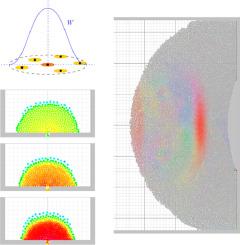Computers & Graphics ( IF 2.5 ) Pub Date : 2021-06-18 , DOI: 10.1016/j.cag.2021.06.005 Wouter van Toll , Thomas Chatagnon , Cédric Braga , Barbara Solenthaler , Julien Pettré

|
In highly dense crowds of humans, collisions between people occur often. It is common to simulate such a crowd as one fluid-like entity (macroscopic), and not as a set of individuals (microscopic, agent-based). Agent-based simulations are preferred for lower densities because they preserve the properties of individual people. However, their collision handling is too simplistic for extreme-density crowds. Therefore, neither paradigm is ideal for all possible densities.
In this paper, we combine agent-based crowd simulation with Smoothed Particle Hydrodynamics (SPH), a particle-based method that is popular for fluid simulation. We integrate SPH into the crowd simulation loop by treating each agent as a fluid particle. The forces of SPH (for pressure and viscosity) then augment the usual navigation behavior and contact forces per agent. We extend the standard SPH model with a dynamic rest density per particle, which intuitively controls the crowd density that an agent is willing to accept. We also present a simple way to let agents blend between individual navigation and fluid-like interactions depending on the SPH density.
Experiments show that SPH improves agent-based simulation in several ways: better stability at high densities, more intuitive control over the crowd density, and easier replication of wave-propagation effects. Also, density-based blending between collision avoidance and SPH improves the simulation of mixed-density scenarios. Our implementation can simulate tens of thousands of agents in real-time. As such, this work successfully prepares the agent-based paradigm for crowd simulation at all densities.
中文翻译:

SPH 人群:基于代理的人群模拟,使用流体动力学达到极端密度
在高度密集的人群中,人与人之间的碰撞经常发生。通常将这样的人群模拟为一个类似流体的实体(宏观),而不是一组个体(微观的、基于代理的)。基于代理的模拟是低密度的首选,因为它们保留了个人的属性。然而,它们的碰撞处理对于极端密度的人群来说过于简单。因此,对于所有可能的密度,这两种范式都不是理想的。
在本文中,我们将基于代理的人群模拟与平滑粒子流体动力学 (SPH) 相结合,这是一种流行的流体模拟的基于粒子的方法。我们通过将每个代理视为流体粒子将 SPH 集成到人群模拟循环中。SPH 的力(压力和粘度)然后增强了通常的导航行为和每个代理的接触力。我们使用每个粒子的动态静止密度扩展了标准 SPH 模型,该模型直观地控制了代理愿意接受的人群密度。我们还提出了一种简单的方法,让代理根据 SPH 密度在单个导航和类似流体的交互之间进行混合。
实验表明,SPH 在几个方面改进了基于代理的模拟:在高密度下更好的稳定性,对人群密度的更直观的控制,以及更容易复制波传播效果。此外,碰撞避免和 SPH 之间基于密度的混合改进了混合密度场景的模拟。我们的实现可以实时模拟数以万计的代理。因此,这项工作成功地为所有密度的人群模拟准备了基于代理的范式。



























 京公网安备 11010802027423号
京公网安备 11010802027423号